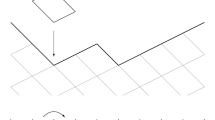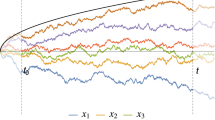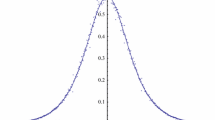Abstract
We study N vicious Brownian bridges propagating from an initial configuration \(\{a_1< a_2< \ldots < a_N \}\) at time \(t=0\) to a final configuration \(\{b_1< b_2< \ldots < b_N \}\) at time \(t=t_f\), while staying non-intersecting for all \(0\le t \le t_f\). We first show that this problem can be mapped to a non-intersecting Dyson’s Brownian bridges with Dyson index \(\beta =2\). For the latter we derive an exact effective Langevin equation that allows to generate very efficiently the vicious bridge configurations. In particular, for the flat-to-flat configuration in the large N limit, where \(a_i = b_i = (i-1)/N\), for \(i = 1, \ldots , N\), we use this effective Langevin equation to derive an exact Burgers’ equation (in the inviscid limit) for the Green’s function and solve this Burgers’ equation for arbitrary time \(0 \le t\le t_f\). At certain specific values of intermediate times t, such as \(t=t_f/2\), \(t=t_f/3\) and \(t=t_f/4\) we obtain the average density of the flat-to-flat bridge explicitly. We also derive explicitly how the two edges of the average density evolve from time \(t=0\) to time \(t=t_f\). Finally, we discuss connections to some well known problems, such as the Chern–Simons model, the related Stieltjes–Wigert orthogonal polynomials and the Borodin–Muttalib ensemble of determinantal point processes.








Similar content being viewed by others
References
Doob, J.L.: Conditional Brownian motion and the boundary limits of harmonic functions. Bull. Soc. Math. Fr. 85, 431 (1957)
Fitzsimmons, P., Pitman, J., Yor, M.: Markovian bridges: construction, Palm interpretation, and splicing, In: Seminar on Stochastic Processes, 1992 ( Springer, 1993) pp. 101–134
Orland, H.: Generating transition paths by Langevin bridges. J. Chem. Phys. 134, 174114 (2011)
Chetrite, R., Touchette, H.: Nonequilibrium microcanonical and canonical ensembles and their equivalence. Phys. Rev. Lett. 111, 120601 (2013)
Majumdar, S.N., Orland, H.: Effective Langevin equations for constrained stochastic processes. J. Stat. Mech. Theor. Exp. 2015, P06039 (2015)
Chetrite, R., Touchette, H.: Nonequilibrium Markov processes conditioned on large deviations. Ann. Henri Poincaré 16, 2005 (2015)
de Gennes, P.G.: Soluble model for fibrous structures with steric constraints. J. Chem. Phys. 48, 2257 (1968)
Fisher, M.E.: Walks, walls, wetting, and melting. J. Stat. Phys. 34, 667 (1984)
Huse, D.A., Fisher, M.E.: Commensurate melting, domain walls, and dislocations. Phys. Rev. B 29, 239 (1984)
Johansson, K.: Non-intersecting paths, random tilings and random matrices. Probab. Theory Rel. 123, 225 (2002)
Prähofer, M., Spohn, H.: Scale invariance of the PNG droplet and the Airy process. J. Stat. Phys. 108, 1071 (2002)
Katori, M., Tanemura, H.: Symmetry of matrix-valued stochastic processes and noncolliding diffusion particle systems. J. Math. Phys. 45, 3058 (2004)
Tracy, C.A., Widom, H.: Nonintersecting brownian excursions. Ann. Appl. Probab. 17, 953 (2007)
Schehr, G., Majumdar, S.N., Comtet, A., Randon-Furling, J.: Exact distribution of the maximal height of p vicious walkers. Phys. Rev. Lett. 101, 150601 (2008a)
Borodin, A., Ferrari, P., Prahofer, M., Sasamoto, T., Warren, J.: Maximum of Dyson Brownian motion and non-colliding systems with a boundary. Electron. Commun. Prob. 14, 486 (2009)
Nadal, C., Majumdar, S.N.: Nonintersecting Brownian interfaces and Wishart random matrices. Phys. Rev. E 79, 061117 (2009)
Rambeau, J., Schehr, G.: Extremal statistics of curved growing interfaces in 1+ 1 dimensions. EPL 91, 60006 (2010)
Forrester, P.J., Majumdar, S.N., Schehr, G.: Non-intersecting Brownian walkers and Yang-Mills theory on the sphere. Nucl. Phys. B 844, 500 (2011)
Schehr, G., Majumdar, S.N., Comtet, A., Forrester, P.J.: Reunion probability of N vicious walkers: typical and large fluctuations for large \(N\). J. Stat. Phys. 150, 491 (2013)
Nguyen, G.B., Remenik, D.: Extreme statistics of non-intersecting Brownian paths. Electron. J. Probab. 22, (2017)
Le Doussal, P., Majumdar, S.N., Schehr, G.: Periodic Airy process and equilibrium dynamics of edge fermions in a trap. Ann. Phys. 383, 312 (2017)
Gautié, T., Le Doussal, P., Majumdar, S.N., Schehr, G.: Non-crossing Brownian paths and Dyson Brownian motion under a moving boundary. J. Stat. Phys. 177, 752 (2019)
Krattenthaler, C., Guttmann, A.J., Viennot, X.G.: Vicious walkers, friendly walkers and Young tableaux: II. With a wall. J. Phys. A 33, 8835 (2000)
Bonichon, N., Mosbah, M.: Watermelon uniform random generation with applications. Theor. Comput. Sci. 307, 241 (2003)
Marino, M.: Chern–Simons theory, matrix integrals, and perturbative three-manifold invariants. Commun. Math. Phys. 253, 25 (2005)
Mariño, M.: Matrix Models and Topological Strings, In: Applications of Random Matrices in Physics, edited by É. Brézin, V. Kazakov, D. Serban, P. Wiegmann, and A. Zabrodin (Springer Netherlands, Dordrecht, 2006) pp. 319–378
Dolivet, Y., Tierz, M.: Chern–Simons matrix models and Stieltjes–Wigert polynomials. J. Math. Phys. 48, 023507 (2007)
Szabo, R.J., Tierz, M.: Chern–Simons matrix models, two-dimensional Yang–Mills theory and the Sutherland model. J. Phys. A 43, 265401 (2010)
Takahashi, Y., Katori, M.: Noncolliding Brownian motion with drift and time-dependent Stieltjes–Wigert determinantal point process. J. Math. Phys. 53, 103305 (2012)
Borot, G., Guionnet, A., Kozlowski, K.K.: Asymptotic expansion of a partition function related to the sinh-model, arXiv: 1412.7721 (Springer, 2016)
Guionnet, A.: First order asymptotics of matrix integrals; a rigorous approach towards the understanding of matrix models. Commun. Math. Phys. 244, 527 (2004)
Bun, J., Bouchaud, J.-P., Majumdar, S.N., Potters, M.: Instanton approach to large N Harish–Chandra–Itzykson–Zuber Integrals. Phys. Rev. Lett. 113, 070201 (2014)
Menon, G.: The complex Burgers’ equation, the HCIZ integral and the Calogero-Moser system, preprint (2017)
Dyson, F.J.: A brownian motion model for the eigenvalues of a random matrix. J. Math. Phys. 3, 1191 (1962)
Dumitriu, I., Edelman, A.: Matrix models for beta ensembles. J. Math. Phys. 43, 5830 (2002)
Rambeau, J., Schehr, G.: Distribution of the time at which N vicious walkers reach their maximal height. Phys. Rev. E 83, 061146 (2011)
Karlin, S., McGregor, J.: Coincidence properties of birth and death processes. Pacific J. Math. 9, 1109 (1959)
Blaizot, J.-P., Nowak, M.A.: Coincidence properties of birth and death processes. Phys. Rev. E 82, 051115 (2010)
Allez, R., Bouchaud, J.-P., Guionnet, A.: Invariant beta ensembles and the Gauss–Wigner crossover. Phys. Rev. Lett. 109, 094102 (2012)
Blaizot, J.-P., Grela, J., Nowak, M.A., Warchoł, P.: Diffusion in the space of complex hermitian matrices. Acta Phys. Pol. B 46, 1801 (2015)
Krajenbrink, A., Doussal, P.L., O’Connell, N.: Tilted elastic lines with columnar and point disorder, non-Hermitian quantum mechanics and spiked random matrices: pinning and localization, preprint arXiv:2009.11284 (2020)
Forrester, P.J.: Global and local scaling limits for the \(\beta = 2\) Stieltjes–Wigert random matrix ensemble, arXiv preprint arXiv:2011.11783 (2020)
Wikipedia, “Cubic equation”, https://en.wikipedia.org/w/index.php?title=Cubic_equation&oldid=1005257159 (2021a)
Wikipedia, “Quartic function”, https://en.wikipedia.org/w/index.php?title=Quartic_function&oldid=1004178910 (2021b)
Forrester, P.J., Grela, J.: Hydrodynamical spectral evolution for random matrices. J. Phys. A 49, 085203 (2016)
Borodin, A.: Biorthogonal ensembles. Nucl. Phys. B 536, 704 (1998)
Muttalib, K.A.: Random matrix models with additional interactions. J. Phys. A 28, L159 (1995)
Borodin, A., Strahov, E.: Averages of characteristic polynomials in random matrix theory. Commun. Pure Appl. Math. 59, 161 (2006)
Forrester, P.J., Liu, D.-Z.: Singular values for products of complex Ginibre Matrices with a source: hard edge limit and phase transition. Commun. Math. Phys. 344, 333 (2016)
Fyodorov, Y.V., Grela, J., Strahov, E.: On characteristic polynomials for a generalized chiral random matrix ensemble with a source. J. Phys. A 51, 134003 (2018)
Grela, J., Nowak, M.A., Tarnowski, W.: Eikonal formulation of large dynamical random matrix models, preprint, arXiv:2010.01690 (2020)
Szmytkowski, R.: On the derivatives \(\partial ^2P_\nu (z)/\partial ^2\nu \) and \(\partial Q_\nu (z)/\partial \nu \) of the Legendre functions with respect to their degrees. Integr. Transf. Spec. Fr. 28, 645 (2017)
Acknowledgements
We thank J.-P. Bouchaud, J. Bun, P. Mergny, H. Orland and M. Potters for useful discussions. This research was supported by ANR grant ANR-17-CE30-0027-01 RaMaTraF. JG acknowledges support by the TEAMNET POIR.04.04.00- 00-14DE/18-00 grant of the Foundation for Polish Science.
Author information
Authors and Affiliations
Corresponding author
Additional information
Communicated by Pierpaolo Vivo.
Publisher's Note
Springer Nature remains neutral with regard to jurisdictional claims in published maps and institutional affiliations.
Appendices
Appendix A: Derivation of Eq. (43)
We recall the definition of characteristic polynomial (42) and formulate its “non-averaged” version
The positions \(x_i\) evolve according to the Langevin equation (36) which is rewritten as the following stochastic differential equation (hereafter SDE)
where the Wiener process is defined by \(dW_i dW_j = \delta _{ij} \frac{1}{N} d\theta \). We compute the evolution equation for \(\tilde{\Omega }_N(y)\) under the stochastic motion (A1). To this end, we use Ito’s lemma
We compute the derivatives as
and find
To obtain a closed equation, each term in the above expression ought to be expressed in terms of \(\tilde{\Omega }_N\). To this end, we compute first partial results
and use them to get
which are plugged back into Eq. (A3) and (A2) to yield
This is a closed equation for \({\tilde{\Omega }}_N\) and the stochastic part is proportional to \(dW_i\). This thus drops out when looking at the averaged characteristic polynomial \(\langle \tilde{\Omega }_N\rangle = \Omega _N\), i.e.,
which is exactly the Eq. (43) given in the text.
Appendix B: Derivation of Eq. (68)
We start from the Sochocki–Plemejl formula relating the particle density and the e-Green’s function H
We use the complex logarithm formula
where k enumerates the branch cuts of the logarithm and where the real and imaginary parts are clearly separated. We also expand \(1/(x-i\epsilon ) = \frac{x+i\epsilon }{x^2+\epsilon ^2}\), plug these two formulas into Eq. (B1) and find
We assume that \(\frac{\epsilon \ln |H(x-i\epsilon )|}{x^2+\epsilon ^2} \rightarrow 0\) as \(\epsilon \rightarrow 0\) and we are left with
We choose the branch \(k=0\) to make the resulting density normalizable (i.e. not divergent) and for \(x>0\) the term \(x/(x^2+\epsilon ^2)\) is regular and can be safely taken out of the limit which finally gives Eq. (68).
Appendix C: Calculation of the Moments of the average density for \(t=t_f/2\).
In this Appendix we compute the moments of the densities \(\rho ^{(x)}\) in Eq. (73) and \(\rho ^{(\lambda )}\) in Eq. (74). We start with \(\rho ^{(x)}\) and set \(w_\pm ^{(1)} = x_\pm \) in Eq. (73). The k-th moment of the average density, using Eq. (73), is then given by
We perform a change of variables \(x = \frac{1}{T} \left( \frac{2}{T} \left( 1+ \sqrt{1-T}p \right) - 1 \right) \), \(dx = \frac{2\sqrt{1-T}}{T^2} dp\) resulting in
We continue with integration by parts. Since by normalization the zeroth moment is unity \(m_{0,\theta =1}^{(x)} = 1\), we continue with \(k \ge 1\) for which the following formula holds:
where \(J_n = \int _{-1}^1 dp p^n/\sqrt{1-p^2}\). These integrals are expressible via Catalan numbers \(C_n = \frac{1}{n+1} \left( {\begin{array}{c}2n\\ n\end{array}}\right) \) since \(J_0 = \pi \), \(J_{2n} = \frac{2\pi (2n-1)}{4^n} C_{n-1}\) and \(J_{2n-1} = 0\) for \(n>0\):
Thus, interestingly, the Catalan numbers also appear here.
An alternative formulation of these moments in terms of the modified Bessel function is possible with the use of an identity \(\int _{-1}^1 dp \frac{e^{-\alpha p}}{\sqrt{1-p^2}} = \pi I_0(\alpha )\) applied to the integrals \(J_n = (-1)^n \lim \limits _{\alpha \rightarrow 0} \frac{\partial ^n}{\partial \alpha ^n} \int _{-1}^1 dp \frac{e^{-\alpha p}}{\sqrt{1-p^2}}\). We find:
where \(a = \sqrt{1-T}\) and \(I_i(x)\) is the modified Bessel function.
Using the relation (39) between particle densities in x and \(\lambda \) spaces, we translate the moments find
We again change the variables:
with \(a = \sqrt{1-T}, b = 1-T/2, c = \log 2 + 2/t_f\). Now with the identity \(\int _{-1}^1 dp \frac{1}{(ap+b)^\alpha \sqrt{1-p^2}} = \frac{\pi }{\sqrt{b^2-a^2}^\alpha } P_\alpha \left( \frac{b}{\sqrt{b^2-a^2}}\right) \) where \(P_\alpha \) is a Legendre function, the moments in \(\lambda \) space are given by:
As a last step, we propose a general identity (found only in special case \(n=2\) in eq. 1.9 of [52] but checked by us numerically in Mathematica for n up to 5):
which renders the final expression:
Although the expression for the moments in the x-space in (C2) is easy to evaluate numerically, evaluating explicitly the moments in the \(\lambda \)-space from Eq. (C3) is difficult due to the apparent lack of explicit formulae for the derivatives of the Legendre function with respect to its degree (see e.g. [52]).
Appendix D: Computation of the Support for the \(\beta =2\) Dyson’s Brownian Motion
We consider the Dyson’s Brownian motion with \(\beta =2\) where the positions \(\lambda _i(t)\) of N particles evolve in time via Eq. (5), starting from the initial positions \(\vec {a}\) at \(t=0\). One defines the Green’s function \(G_N(z,t)\)
The average density can be obtained via the Sochocki–Plemelj formula
In the large N limit, this converges to
where \(\rho (\lambda ;t)\) is the average density at time t. Thus the initial condition for G(z; t) reads
where \(\rho (\lambda ;0)\) is the initial density. In the large N limit, one can show that G(z, t) satisfies the inviscid Burgers’ equation [38,39,40,41]
The solution can be obtained in the parametric form by the method of characteristics, as discussed in Sect. 3. It reads
where \(\xi \) and z are related by
Given z and t, we need to solve Eq. (D7) for \(\xi \) and then substitute in Eq. (D6) to obtain G(z; t).
Let us first discuss some general properties of the Green’s function G(z; t). Consider first G(z; t) as a function of z along the positive real axis. An exactly similar analysis can be done on the negative real axis. From the definition in Eq. (D1), it is clear that as \(z \rightarrow \infty \), \(G(z;t) \simeq 1/z\) since \(\rho (\lambda ;t)\) is normalized to 1. As z decreases from \(+\infty \), G(z; t) typically increases with decreasing z. However, this does not go on for ever since we expect that there will be a cut along the real axis where G(z; t) acquires a nonzero imaginary part, which gives rise to a nonzero density via Eq. (D2). Let \(z_{\mathrm{edge}}(t)\) denote this value of z below which G(z; t) is imaginary. Clearly, this is also the upper edge of the support of the density. Thus in the range \([z_{\mathrm{edge}}(t), +\infty )\), G(z; t) is a monotonically decreasing function of z. Similarly, the function \(G_0(\xi )\) is, generically, a monotonically decreasing function of \(\xi \) for \(\xi \in [\xi _{\mathrm{edge}}, +\infty )\) and decays for large \(\xi \) as \(G_0(\xi ) \simeq 1/\xi \). Note that, for simplicity, we have presented only the behavior for the upper edge of the support of the density. A similar analysis can be done for the lower edge of the support, for which we need to analyse the Green’s function G(z; t) on the negative real axis in the complex z-plane.
Given z and t, we now want to find the solution for \(\xi \) from Eq. (D7). Suppose that we plot z as a function of \(\xi \) for \(\xi > \xi _{\mathrm{edge}}\). The rhs of (D7) is the sum of two terms: the first one increases linearly with \(\xi \) while the second term, for fixed t, is a decreasing function of \(\xi \). Hence their sum, when plotted as a function of \(\xi \) will first decrease with increasing \(\xi \), achieves a minimum at \(\xi _c(t)\) and then increases monotonically with \(\xi \) (see Fig. 9). For a given z and t, this equation (D7) has typically two solutions \(\xi _1(z) < \xi _2(z)\). Here, \(\xi _2(z)\) is a monotonically increasing function of z, while \(\xi _1(z)\) is a monotonically decreasing function of z (see Fig. 9). The correct solution is actually given by \(\xi _2(z)\). This is because from Eq. (D6) we see that since G(z; t) is a monotonically decreasing function of z and \(G_0(\xi )\) is also a monotonically decreasing function of \(\xi \), hence z must be a monotonically increasing function of \(\xi \). This justifies the fact that \(\xi _2(z)\) is the correct root. Note however that \(\xi _2(z)\) exists only if \(z \ge z_c(t)\) where \(z_c(t)\) is the value of \(z(\xi ) = \xi + t \, G_0(\xi )\) at the minimum located at \(\xi = \xi _c(t)\) (see Fig. 9). This minimum is obtained by setting
Plot of \(z(\xi )\) in Eq. (D7) for \(G_0(\xi ) = 1/\xi \) and \(t=1/2\)
This gives the value \(\xi _c(t)\) and consequently
Therefore we see that the real solution exists only for \(z \ge z_c(t)\). Thus we identify
As an example, let us consider the simple case where all the particles start at the origin, i.e. \(\rho (\lambda ;0) = \delta (\lambda )\). In this case, from Eq. (D4) we have \(G_0(\xi ) = 1/\xi \). In this case \(\xi _{\mathrm{edge}} = 0\). Consequently, from Eq. (D8), we get
Note that \(\xi _c(t)\) has nothing to do with \(\xi _{\mathrm{edge}}\). Here we are considering the positive side of the support, hence we choose the positive root in (D11). Similarly, when analyzing the lower edge of the support, we should instead choose the negative root \(\xi _c(t) = - \sqrt{t}\). From Eq. (D9) one gets for the positive side
This result tells us how the upper support of the average density evolves with time t. Indeed, in this case, one can solve for \(\xi \) from the quadratic equation \(z = \xi + t/\xi \), which gives two roots: \(\xi _1(z) = (z - \sqrt{z^2-4})/2\) and \(\xi _2(z) = (z + \sqrt{z^2-4t})/2\). As argued earlier, we choose the second branch as the correct one, i.e., \(\xi = (z + \sqrt{z^2-4t})/2\). Consequently, from Eq. (D6) one gets
Therefore, from the relation (D2), the average density at time t is given by the semi-circular form
Hence we see that the density is supported over the interval \([-\sqrt{4t},+\sqrt{4t}]\) and indeed the upper support \(\sqrt{4t}\) coincides with the value of \(z_c(t)=z_{\mathrm{edge}}(t)\) in Eqs. (D10) and (D12).
Rights and permissions
About this article
Cite this article
Grela, J., Majumdar, S.N. & Schehr, G. Non-intersecting Brownian Bridges in the Flat-to-Flat Geometry. J Stat Phys 183, 49 (2021). https://doi.org/10.1007/s10955-021-02774-6
Received:
Accepted:
Published:
DOI: https://doi.org/10.1007/s10955-021-02774-6





